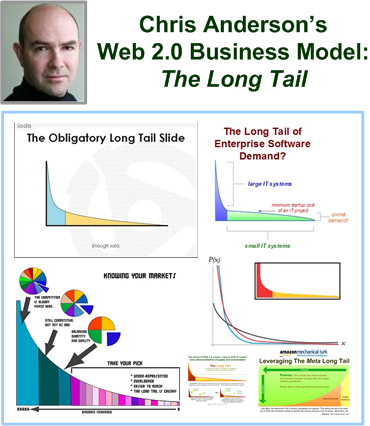Chris Anderson, Editor-in-Chief of Wired Magazine, has been discussing a concept he calls The Long Tail for quite some time now. Many of you have no doubt been reading his excellent blog on the subject, and now finally his long-awaited book about this key Web 2.0 business model has been published. The actual launch day was just over a week ago (some great coverage of this by Chris), yet The Long Tail has long since emerged into the collective consciousness of business and technology thought leaders everywhere. It was even prominently cited in Tim O’Reilly’s seminal essay on What Is Web 2.0 (top of page two), where he gives the concept a lot of credit for creating some of the Web’s major successes:
“Overture and Google’s success came from an understanding of what Chris Anderson refers to as “the long tail,” the collective power of the small sites that make up the bulk of the web’s content.” – Tim O’Reilly

For those who haven’t been tracking it, The Long Tail essentially describes the mass servicing of micromarkets, which is primarily made possible, even cost effective, by the delivery system of the Web itself. This is what the subtitle of the book puts another way as Why The Future of Business is Selling Less of More. And it’s not some obscure buzzword, I’ve found The Long Tail to be an indispensable short hand in describing certain concepts and trends we see emerging in business and the Web these days. For example, I’ve described Amazon’s innovative Mechanical Turk as a yet another one of their brilliant “long tail” plays. So too how The Long Tail of enterprise software demand is finally being tapped using Web 2.0 technologies to cost effectively serve previously underserved portions of the enterprise which couldn’t previously justify the the expense, most notably in articles on ZDNet and here.
And I’m far from being the only one. The term is a popular in the blogosphere in general and is frequently a hot topic of discussion. And while sometimes the term does feel overused or misapplied – and still makes all-too-frequent appearance in marketing slides – it has serious legs in being the only catchy and effective descriptor of an otherwise seemingly obscure statistical anomaly. Thus, I say ignore The Long Tail at your peril; fortunes will continues to be won and lost over how well it’s understood and exploited. Here’s a big congratulations to Chris for so diligently and effectively bringing all of us this epiphany.
Other great coverage of The Long Tail recently:
– Don’t Get Confused By The Long Tail – Matthew Hurst
– Wagging The Tail – Jon Howard
– The Wrong Tail: A Checklist for Long Tail Implementations – Guy Kawasaki
– The Long Tail of Revenue 2.0 – Scott Karp
– The Economist does The Long Tail – Chris Anderson
– Update: John Hagel does some pentrating analysis of the concepts, post-book release
– Update: Lee Gomes of the Wall Street Journal has his take on The Long Tail and it’s extremely interesting. My take, given a content set with equal discoverability, The Long Tail is there.
Chris also made a terrific appearance on National Public Radio earlier this week and the audiocast is now available online. It offers an extremely informative and entertraining overview of the concept, including the homage Budweiser paid to Chris’ concept with the creation of their Long Tail Libations brand. If this doesn’t indicate that The Long Tail is entering mainstream consciousness, nothing will. So study The Long Tail, add it to your arsenal of New Internet business models (along with Gaining Control over Hard to Recreate Data Sources, Encouraging Unintended Uses, Applications as Platforms, and Customer Self-Service), and use them to create some terrific next generation Web businesses.
Can you think of any interesting new real-world examples of The Long Tail?
